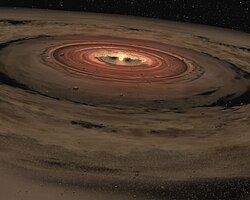OTS 44
| Observation data Epoch J2000.0 Equinox J2000.0 |
|
|---|---|
| Constellation | Chamaeleon |
| Right ascension | 11h 10m 11.5s |
| Declination | −76° 32′ 13″ |
| Characteristics | |
| Spectral type | M9.5 |
| Astrometry | |
| Distance | 554 ly (170 pc) |
| Details | |
| Mass | 0.011 M☉ |
| Radius | 0.23–0.57 R☉ |
| Luminosity | 0.0013–0.0024 L☉ |
| Temperature | 1,700–2,300 K |
| Database references | |
| SIMBAD | data |
OTS 44 is a free-floating planetary-mass object or brown dwarf located at 550 light-years (170 pc) in the constellation Chamaeleon. It is among the lowest-mass free-floating substellar objects, with approximately 11.5 times the mass of Jupiter, or approximately 1.1% that of the Sun. Its radius is not very well known and is estimated to be 23–57% that of the Sun.
OTS 44 was discovered in 1998 by Oasa, Tamura, and Sugitani as a member of the star-forming region Chamaeleon I. Based upon infrared observations with the Spitzer Space Telescope and the Herschel Space Observatory, OTS 44 emits an excess of infrared radiation for an object of its type, suggesting it has a circumstellar disk of dust and particles of rock and ice. This disk has a mass of at least 10 Earth masses. Observations with the SINFONI spectrograph at the Very Large Telescope show that the disk is accreting matter at the rate of approximately 10−11 of the mass of the Sun per year. It could eventually develop into a planetary system.
...
Wikipedia

